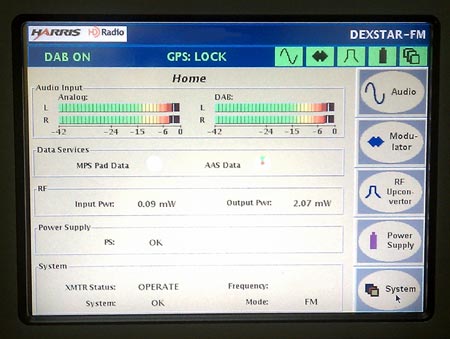Since the FCC approved a tenfold increase in the radiated power of the digital carrier, a progress report on the digital radio rollout is in order. The FCC report and order (MM Docket No. 99-325) give us some background:
An original goal of the developers of the hybrid FM IBOC DAB system was replication of FM analog coverage without adversely affecting either the host analog signal or adjacent channel analog FM operations. iBiquity and several independent parties conducted extensive field and laboratory tests. Based on the National Radio Systems Committee (“NRSC”) evaluation of those test results, iBiquity requested and the NRSC approved an FM Digital ERP of one percent of FM Analog ERP (20 decibels below carrier (-20 dBc)).
And (after paying gobs of license fees and installation costs):
Many FM stations promptly commenced hybrid FM IBOC operations. Despite the rigorous testing, it soon became apparent that hybrid FM IBOC digital coverage often did not replicate analog coverage, especially in mobile and indoor environments.
Therefore (Fox, here are the keys to the hen house, knock yourself out):
Based on the results of the experimental operations with increased FM Digital ERP and other studies, on June 10, 2008, a group consisting of 18 radio group owners that operate over 1,200 commercial and noncommercial educational (“NCE”) FM stations and the four largest broadcast transmission equipment manufacturers, identifying themselves as “Joint Parties,” requested (the “Joint Parties Request”) that the Commission generally increase maximum permissible FM Digital ERP10 from one percent of a station’s authorized analog ERP (-20 dBc) (1% FM IBOC Power”) to a maximum of ten percent of a station’s authorized analog ERP (-10 dBc) (“10% FM IBOC Power”).
Based on (We find these hens are delicious!):
NPR concluded that at 1% FM IBOC Power, the mobile, indoor and portable digital coverage achieved by most FM stations would not replicate analog coverage, but that at 10% FM IBOC Power most FM stations could achieve digital mobile, portable and indoor coverage levels which either met or exceeded comparable analog coverage levels.
And (in spite of numerous concerns by the public and other broadcasters) Viola:
73.404 Interim Hybrid IBOC DAB Operation.
(a) The licensee of an AM or FM station, or the permittee of a new AM or FM station which has commenced program test operation pursuant to § 73.1620, may commence interim hybrid IBOC DAB operation with digital facilities which conform to the technical specifications specified for hybrid DAB operation in the First Report and Order in MM Docket No. 99-325, as revised in the Media Bureau’s subsequent Order in MM Docket No. 99-325. FM stations are permitted to operate with hybrid digital effective radiated power equal to one percent (-20 decibels below carrier (dBc)) of authorized analog effective radiated power and may operate with up to ten percent (-10 dBc) of authorized analog effective radiated power in accordance with the procedures set forth in the Media Bureau’s Order in MM Docket No 99-325. An AM or FM station may transmit IBOC signals during all hours for which the station is licensed to broadcast.
Notice how they stuck AM nighttime operation in there too. Now I get to hear IBOC signals over riding adjacent channel stations that used to come in clearly via skywave. One tends to wonder if this interference is not deliberate. Crush the small operators with interference, make their stations worthless, drive them out of business…
To help things along, iBiquity has offered to reduce their licensing fees to $5,000.00 (oops, its more like $10,500 – 12,500). These rules were put into effect on January 29, 2010. According to the FCC database, there are 1524 FM stations and 292 AM stations transmitting IBOC. That breaks down to 15% of the FM stations and 6% of the AM stations. I will post an update if there is a sudden rush to install IBOC. Still a pretty low penetration for a 10-20-year-old technology. It is likely these low numbers are the reason why both broadcast bands are still mostly listenable, at least from a technical perspective.
As the noise floor rises and the competing stations sink further and further into the mud, the audience will turn to non-static-filled technologies to listen to their music and other programs.

